Economic Assessment of Demand Response Using Coupled National and Regional Optimisation Models
Abstract
1. Introduction
- Where are DR units allocated in a high-resolution German power grid model and when are they dispatched?
- What is the average break-even revenue for DR from a generalised system’s perspective and a more detailed regional perspective?
- Which technologies are most economically viable?
- What are the influences on the economic viability of demand response?
2. Methods and Input Data
2.1. Demand Response Potential and Costs
2.2. Optimisation at the National Level
2.2.1. DR Integration into the Objective Function of the eTraGo Energy System Model
2.2.2. Boundary Conditions for the DR Implementation
2.3. Optimisation at the Regional Level
2.4. Economic Assessment
3. Results and Discussion
3.1. Optimisation at the National Level
3.1.1. DR Dispatch Analysis
3.1.2. DR Allocation Analysis
3.2. Optimisation at the Regional Level
3.3. Economic Assessment
3.4. Sensitivity Analysis
3.4.1. Influence of Spatial and Temporal Energy System Model Resolution
3.4.2. Influence of Heat Pump Size Classes and the Weather Year
3.4.3. Influence of Uncertainties in the Open-Source Power Grid Model and Cost Parameters
3.5. Critical Appraisal
4. Conclusions and Outlook
Supplementary Materials
Author Contributions
Funding
Data Availability Statement
Acknowledgments
Conflicts of Interest
Nomenclature
| AC | Air conditioning |
| an | Annualised |
| cool | Cooling |
| CTS | Commercial, trade and services |
| DHW | Domestic hot water |
| DR | Demand response |
| eTraGo | Electric Transmission Grid Optimisation |
| gen | Generation |
| ICT | Information and communication technology |
| ind | Industrial |
| inst | Installed |
| LOPF | Linear optimal power flow |
| PtG | Power-to-gas |
| PtH | Power-to-heat |
| pu | Per unit |
| PV | Photovoltaics |
| PyPSA | Python for Power System Analysis |
| region4FLEX | Region For Flexibility |
| res | Residential |
| stor | Storage |
| VRE | Variable renewable energy sources |
| sh | Space heating |
| vent | Ventilation |
| c | DR technology index |
| i | Power grid node index |
| t | Hour of the year |
| g | Generator index |
| s | Storage unit index |
| Time frame of management | |
| L | Scheduled load |
| P | Load increase/decrease (DR dispatch) |
| E | Preponed/postponed energy (filling level) |
| Maximum capacity | |
| Load decrease/increase share | |
| Maximum load decrease/increase potential | |
| Maximum energy postponing/preponing potential | |
| Installed DR capacity | |
| Specific investment costs | |
| Specific annual fixed costs | |
| Specific variable costs | |
| PVA | Present value of an annuity factor |
| p | Number of periods (years) |
| d | Discount rate |
| NPV | Net present value |
| r | Revenue for applying DR |
| R | Pearson correlation coefficient |
Appendix A. Modification of the Temporal and Spatial Resolution of the DR Potential Input Data
References
- Li, L.; Lin, J.; Wu, N.; Xie, S.; Meng, C.; Zheng, Y.; Wang, X.; Zhao, Y. Review and outlook on the international renewable energy development. Energy Built Environ. 2020, 3, 139–157. [Google Scholar] [CrossRef]
- Shahzad, F.; Fareed, Z. Examining the relationship between fiscal decentralization, renewable energy intensity, and carbon footprints in Canada by using the newly constructed bootstrap Fourier Granger causality test in quantile. Environ. Sci. Pollut. Res. 2022, 1–10. [Google Scholar] [CrossRef] [PubMed]
- European Commission. Amendment to the Renewable Energy Directive to Implement the Ambition of the New 2030 Climate Target; European Commission: Brusseles, Belgium, 2021; Available online: https://ec.europa.eu/info/sites/default/files/amendment-renewable-energy-directive-2030-climate-target-with-annexes_en.pdf (accessed on 27 September 2022).
- Luz, T.; Moura, P. 100 Percent Renewable energy planning with complementarity and flexibility based on a multi-objective assessment. Appl. Energy 2019, 255, 113819. [Google Scholar] [CrossRef]
- Christian, D.; Anna, G. Integration of Renewable Energy by Distributed Energy Storages. In Advances in Energy Storage: Latest Developments from R&D to the Market; Wiley: Hoboken, NJ, USA, 2022; pp. 839–850. [Google Scholar]
- Shafiekhani, M.; Ahmadi, A.; Homaee, O.; Shafie-khah, M.; Catalão, J.P. Optimal bidding strategy of a renewable-based virtual power plant including wind and solar units and dispatchable loads. Energy 2022, 239, 122379. [Google Scholar] [CrossRef]
- Cai, Q.; Xu, Q.; Qing, J.; Shi, G.; Liang, Q.M. Promoting wind and photovoltaics renewable energy integration through demand response: Dynamic pricing mechanism design and economic analysis for smart residential communities. Energy 2022, 261, 125293. [Google Scholar] [CrossRef]
- Zöphel, C.; Schreiber, S.; Müller, T.; Möst, D. Which flexibility options facilitate the integration of intermittent renewable energy sources in electricity systems? Curr. Sustain. Energy Rep. 2018, 5, 37–44. [Google Scholar] [CrossRef]
- Valdes, J.; González, A.B.P.; Camargo, L.R.; Fenández, M.V.; Macia, Y.M.; Dorner, W. Industry, flexibility, and demand response: Applying German energy transition lessons in Chile. Energy Res. Soc. Sci. 2019, 54, 12–25. [Google Scholar] [CrossRef]
- Misconel, S.; Zöphel, C.; Möst, D. Assessing the value of demand response in a decarbonized energy system—A large-scale model application. Appl. Energy 2021, 299, 117326. [Google Scholar] [CrossRef]
- Gils, H.C. Balancing of Intermittent Renewable Power Generation by Demand Response and Thermal Energy Storage. Ph.D. Thesis, University of Stuttgart, Stuttgart, Germany, 2015. [Google Scholar]
- Paulus, M.; Borggrefe, F. The potential of demand-side management in energy-intensive industries for electricity markets in Germany. Appl. Energy 2011, 88, 432–441. [Google Scholar] [CrossRef]
- Mueller, T.; Moest, D. Demand Response Potential: Available when Needed? Energy Policy 2018, 115, 181–198. [Google Scholar] [CrossRef]
- Kies, A.; Schyska, B.U.; Von Bremen, L. The demand side management potential to balance a highly renewable European power system. Energies 2016, 9, 955. [Google Scholar] [CrossRef]
- Kirkerud, J.; Nagel, N.O.; Bolkesjø, T. The role of demand response in the future renewable northern European energy system. Energy 2021, 235, 121336. [Google Scholar] [CrossRef]
- Gils, H.C. Economic potential for future demand response in Germany–Modeling approach and case study. Appl. Energy 2016, 162, 401–415. [Google Scholar] [CrossRef]
- Gangale, F.; Vasiljevska, J.; Covrig, C.F.; Mengolini, A.; Fulli, G. Smart Grid Projects Outlook 2017: Facts, Figures and Trends in Europe; Joint Research Centre of the European Commission: Petten, The Netherlands, 2017. [Google Scholar] [CrossRef]
- Filusch, T.; Heilmann, A.; Lange, M.; Linnemann, J.; Erfurth, J.; Klug, S. Industrielle Lasten: Auf Dem Weg in die CO2-Neutrale Produktion. Enera Projektkompendium. 2021. Available online: https://projekt-enera.de/wp-content/uploads/enera-projektkompendium.pdf (accessed on 27 September 2022).
- Meyer, T. Dynamische Stromtarife für Privathaushalte. NEW 4.0 Norddeutsche Energiewende. 2020. Available online: https://new4-0.erneuerbare-energien-hamburg.de/de/new-40-blog/details/new-4-0-abschlussbroschuere-veroeffentlichung-zum-start-der-sinteg-abschlusskonferenz-2020.html?file=files/new40/upload/downloads/2020/New%204.0-Abschlussbroschuere.pdf (accessed on 27 September 2022).
- Zhang, K.; Zhou, S. Data-driven analysis of electric vehicle charging behavior and its potential for demand side management. In IOP Conference Series: Earth and Environmental Science, Proceedings of the 2018 International Conference on Advanced Technologies in Energy, Environmental and Electrical Engineering (AT3E 2018), Qingdao, China, 26–28 October 2018; IOP Publishing: Bristol, UK, 2019; Volume 223, p. 012034. [Google Scholar]
- Müller, U.P.; Schachler, B.; Scharf, M.; Bunke, W.D.; Günther, S.; Bartels, J.; Pleßmann, G. Integrated techno-economic power system planning of transmission and distribution grids. Energies 2019, 12, 2091. [Google Scholar] [CrossRef]
- Heitkoetter, W. region4FLEX. 2021. Available online: https://wiki.openmod-initiative.org/wiki/Region4FLEX (accessed on 27 September 2022).
- Remer, D.S.; Nieto, A.P. A compendium and comparison of 25 project evaluation techniques. Part 1: Net present value and rate of return methods. Int. J. Prod. Econ. 1995, 42, 79–96. [Google Scholar] [CrossRef]
- Frysztacki, M.M.; Hörsch, J.; Hagenmeyer, V.; Brown, T. The strong effect of network resolution on electricity system models with high shares of wind and solar. Appl. Energy 2021, 291, 116726. [Google Scholar] [CrossRef]
- Heitkoetter, W.; Schyska, B.U.; Schmidt, D.; Medjroubi, W.; Vogt, T.; Agert, C. Assessment of the regionalised demand response potential in Germany using an open source tool and dataset. Adv. Appl. Energy 2020, 1, 100001. [Google Scholar] [CrossRef]
- Steurer, M. Analyse von Demand Side Integration im Hinblick auf Eine Effiziente und Umweltfreundliche Energieversorgung. Ph.D. Thesis, Universität Stuttgart, Institut für Energiewirtschaft und Rationelle Energieanwendung, Stuttgart, Germany, 2017. [Google Scholar]
- Pellinger, C.; Schmid, T.; Regett, A.; Gruber, A.; Conrad, J.; Wachinger, K.; Fischhaber, S. Merit Order der Energiespeicherung im Jahr 2030-Hauptbericht; Forschungsstelle für Energiewirtschaft eV (FfE): München, Germany, 2016. [Google Scholar]
- Crosson, S.V.; Needles, B.E. Managerial Accounting; Houghton Mifflin Co.: Boston, MA, USA, 2008. [Google Scholar]
- Wienholt, L.; Müller, U.P.; Bartels, J. Optimal Sizing and Spatial Allocation of Storage Units in a High-Resolution Power System Model. Energies 2018, 11, 3365. [Google Scholar] [CrossRef]
- Hülk, L.; Wienholt, L.; Cußmann, I.; Müller, U.P.; Matke, C.; Kötter, E. Allocation of annual electricity consumption and power generation capacities across multiple voltage levels in a high spatial resolution. Int. J. Sustain. Energy Plan. Manag. 2017, 13, 79–92. [Google Scholar]
- 50 Hertz Transmission GmbH; Amprion GmbH; TenneT TSO GmbH; TransnetBW GmbH (TSOs). Netzentwicklungsplan Strom 2025, Version 2015. Erster Entwurf der Übertragungsnetzbetreiber. 2015. Available online: https://www.netzentwicklungsplan.de/sites/default/files/paragraphs-files/NEP_2025_1_Entwurf_Teil1_0.pdf (accessed on 27 September 2022).
- Brown, T.; Hörsch, J.; Schlachtberger, D. PyPSA: Python for Power System Analysis. J. Open Res. Softw. 2018, 6. [Google Scholar] [CrossRef]
- Hartigan, J.A.; Wong, M.A. Algorithm AS 136: A k-means clustering algorithm. J. R. Stat. Soc. Ser. Appl. Stat. 1979, 28, 100–108. [Google Scholar] [CrossRef]
- Hörsch, J.; Brown, T. The role of spatial scale in joint optimisations of generation and transmission for European highly renewable scenarios. In Proceedings of the 2017 14th International Conference on the European Energy Market (EEM), Dresden, Germany, 6–9 June 2017; IEEE: Piscataway, NJ, USA, 2017; pp. 1–7. [Google Scholar]
- Deutsche Energieagentur (DENA). Handbuch Lastmanagement, 2012. Available online: https://www.dena.de/newsroom/publikationsdetailansicht/pub/handbuch-lastmanagement/ (accessed on 27 September 2022).
- Shahidehpour, M.; Yamin, H.; Li, Z. Arbitrage in Electricity Markets. In Market Operations in Electric Power Systems; John Wiley and Sons, Ltd.: Hoboken, NJ, USA, 2002; Chapter 5; pp. 161–189. [Google Scholar] [CrossRef]
- Deutsche Energieagentur (DENA). Marktentwicklung Lastmanagement in Deutschland. 2015. Available online: https://www.dena.de/newsroom/meldungen/lastmanagement-dena-empfiehlt-massnahmen-zur-marktentwicklung/ (accessed on 27 September 2022).
- Darby, S. Smart metering: What potential for householder engagement? Build. Res. Inf. 2010, 38, 442–457. [Google Scholar] [CrossRef]
- German Federal Office for Information Security. Allgemeinverfügung zur Feststellung der technischen Möglichkeit zum Einbau intelligenter Messsysteme. 2020. Available online: https://www.bsi.bund.de/SharedDocs/Downloads/DE/BSI/SmartMeter/Marktanalysen/Allgemeinverfuegung_Feststellung_Einbau_01_2020.pdf?__blob=publicationFile&v=4 (accessed on 27 September 2022).
- Pineda, S.; Morales, J.M. Chronological time-period clustering for optimal capacity expansion planning with storage. IEEE Trans. Power Syst. 2018, 33, 7162–7170. [Google Scholar] [CrossRef]
- Viole, I. Temporal Complexity Reduction for Modeling the Sector Coupling of Gas and Electricity; Beuth University of Applied Sciences: Berlin, Germany, 2020. [Google Scholar]
- Heitkoetter, W.; Medjroubi, W.; Vogt, T.; Agert, C. Regionalised heat demand and power-to-heat capacities in Germany—An open dataset for assessing renewable energy integration. Appl. Energy 2020, 259, 114161. [Google Scholar] [CrossRef]
- German Meteorological Service. CDC—Climate Data Centre. 2018. Available online: https://cdc.dwd.de/portal/ (accessed on 27 September 2022).
- Peters, D.; Heitkoetter, W.; Völker, R.; Möller, A.; Gross, T.; Petters, B.; Schuldt, F.; von Maydell, K. Validation of an open source high voltage grid model for AC load flow calculations in a delimited region. IET Gener. Transm. Distrib. 2020, 14, 5870–5876. [Google Scholar] [CrossRef]
- Federal Network Agency. Monitoringbericht 2020. 2021. Available online: https://www.bundesnetzagentur.de/DE/Sachgebiete/ElektrizitaetundGas/Unternehmen_Institutionen/DatenaustauschundMonitoring/Monitoring/Monitoring_Berichte_node.html (accessed on 27 September 2022).
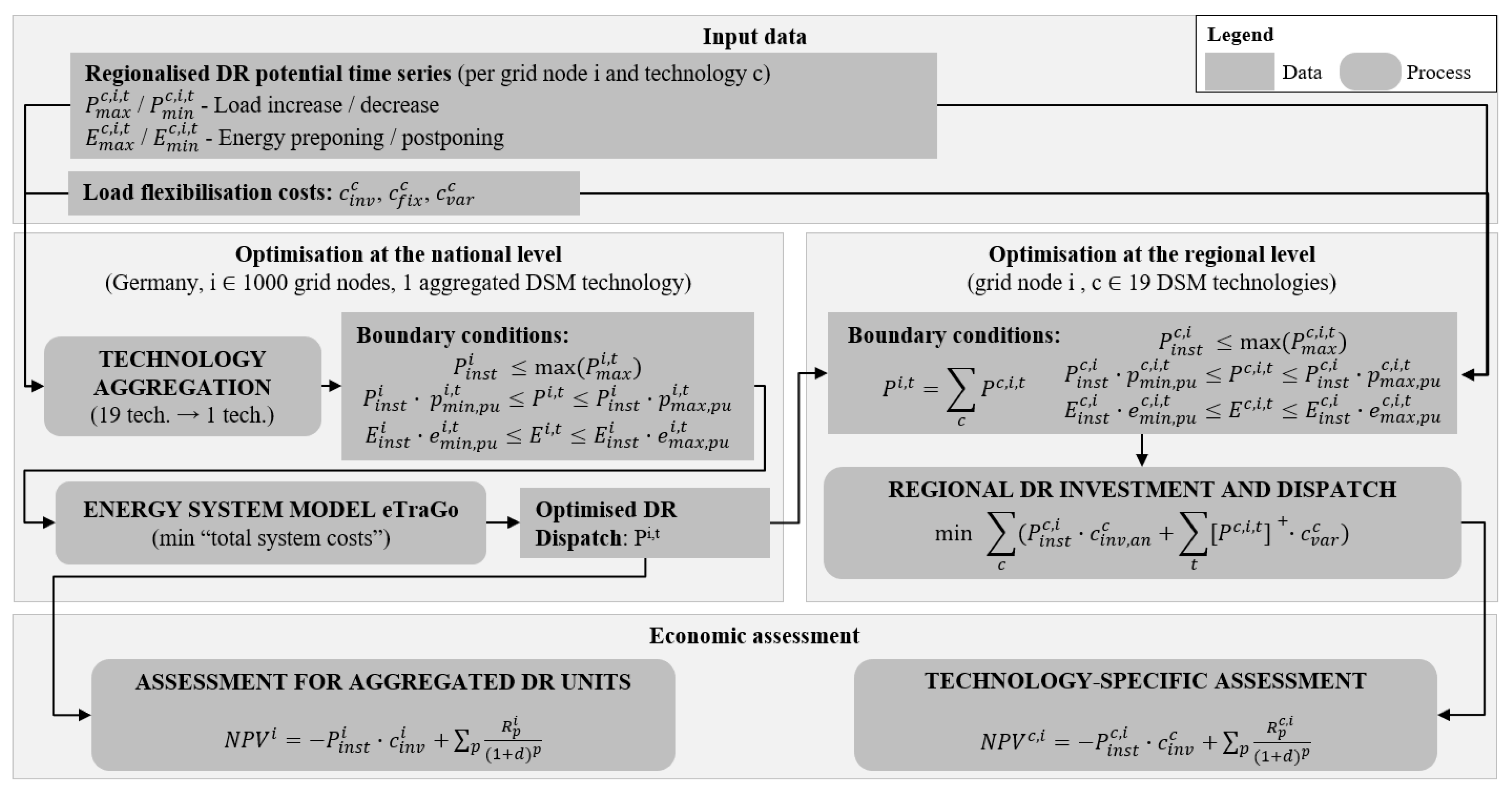
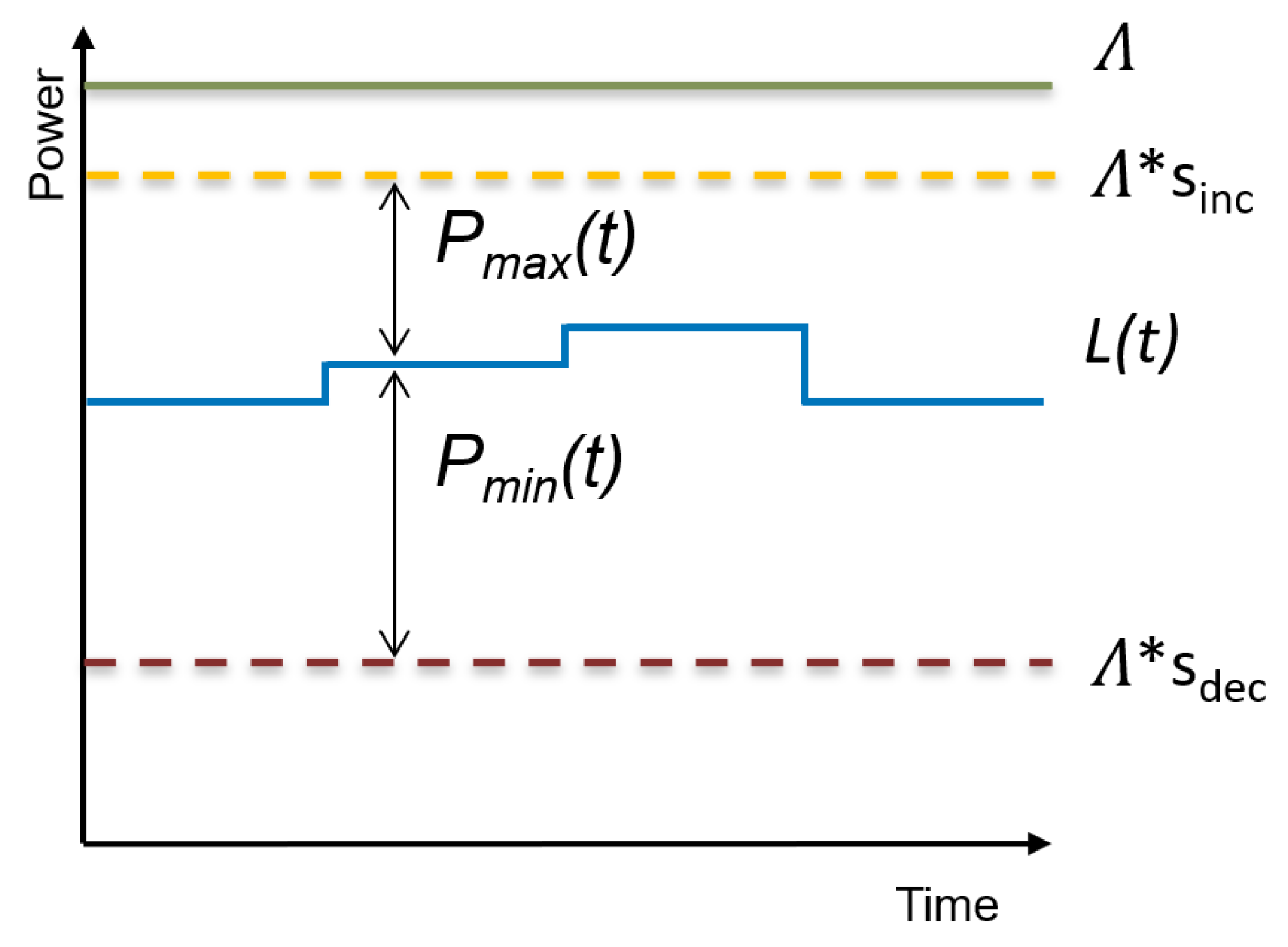

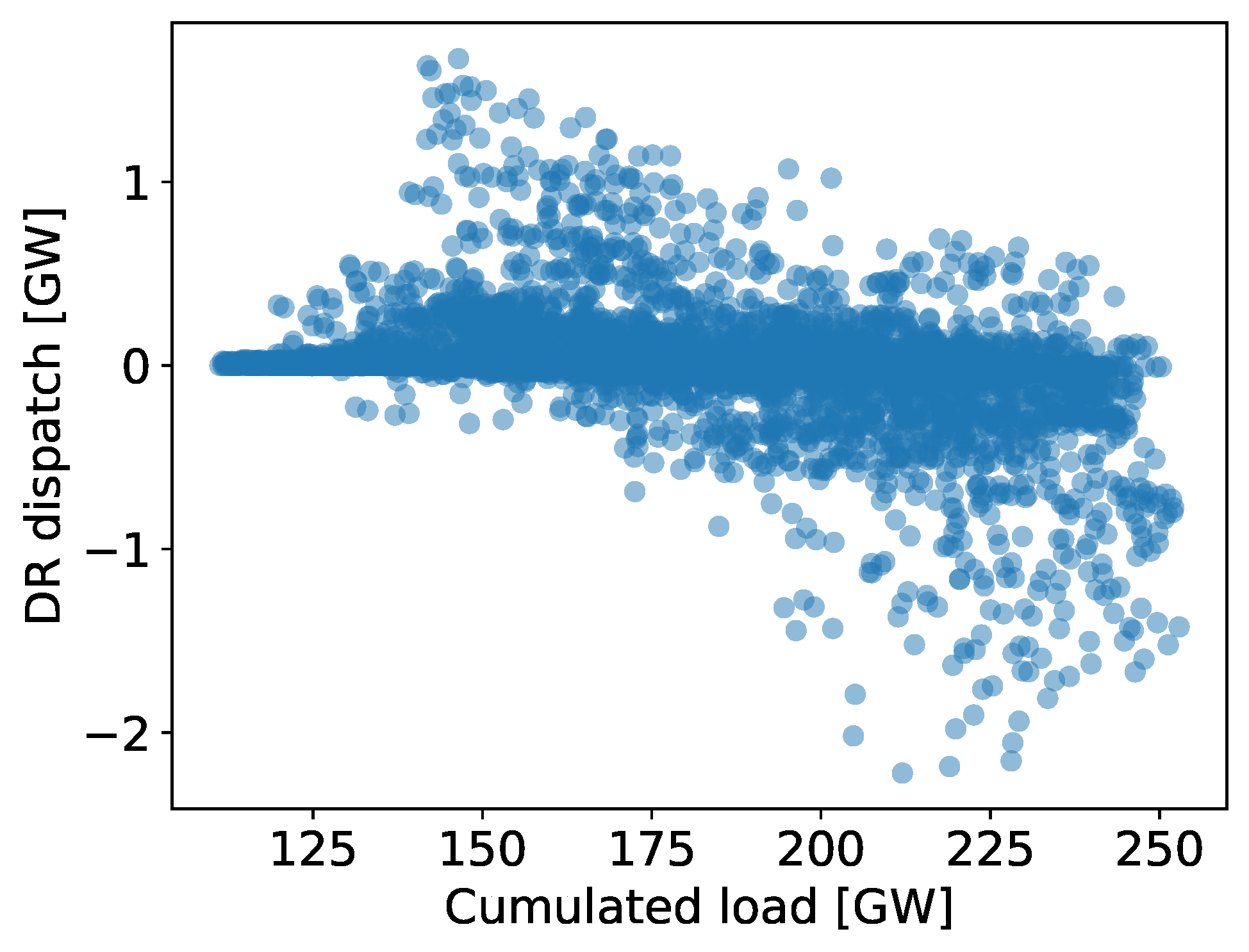
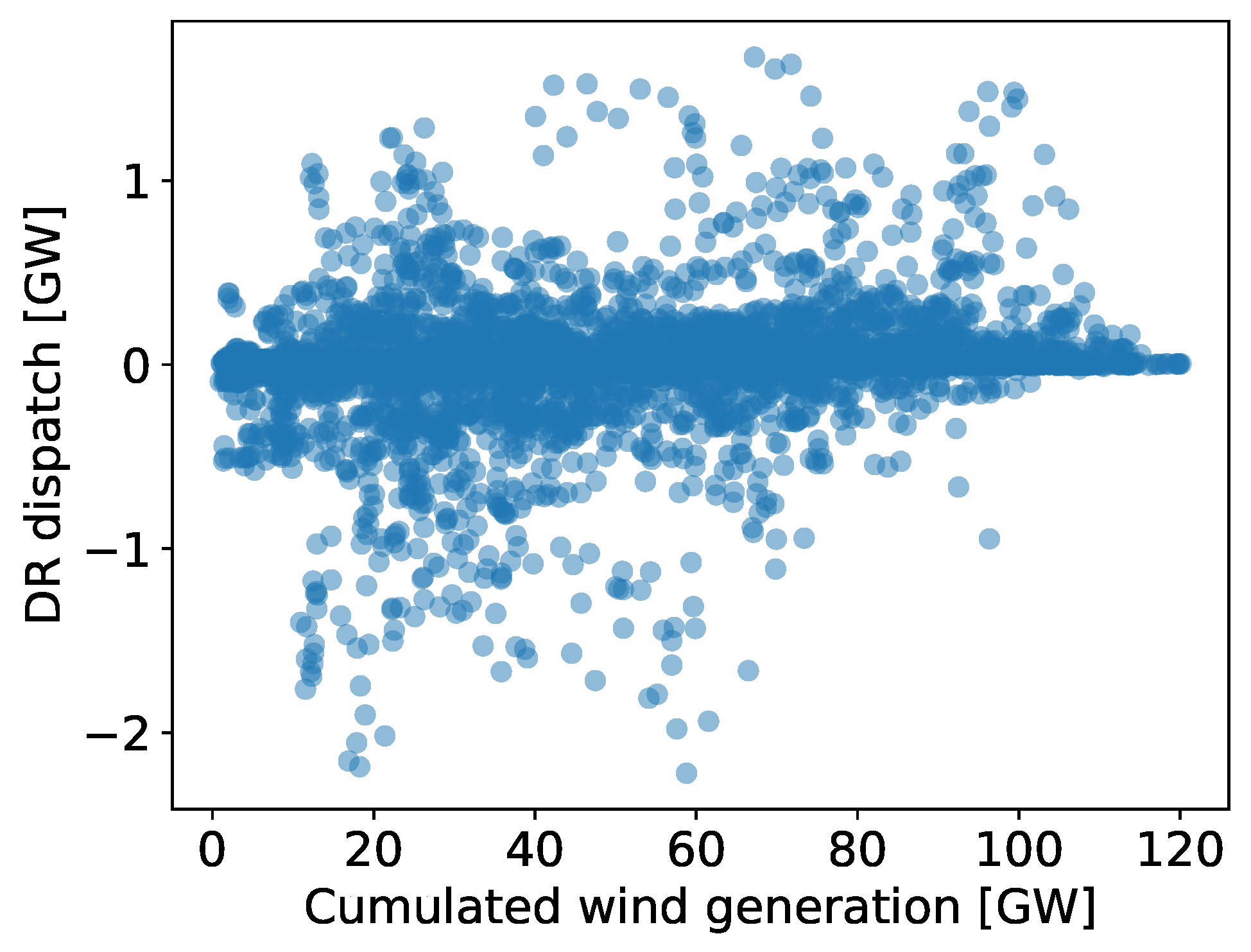
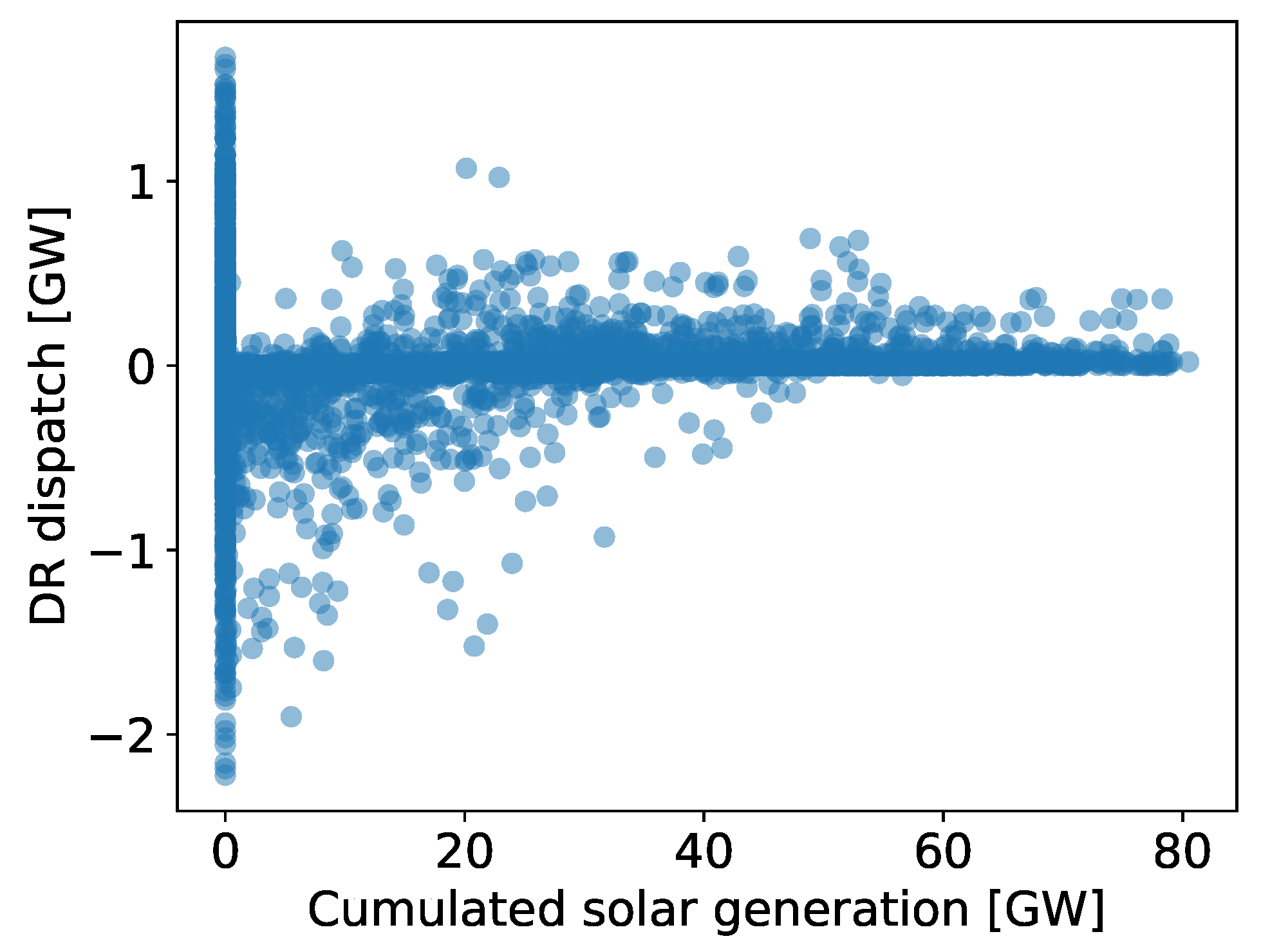
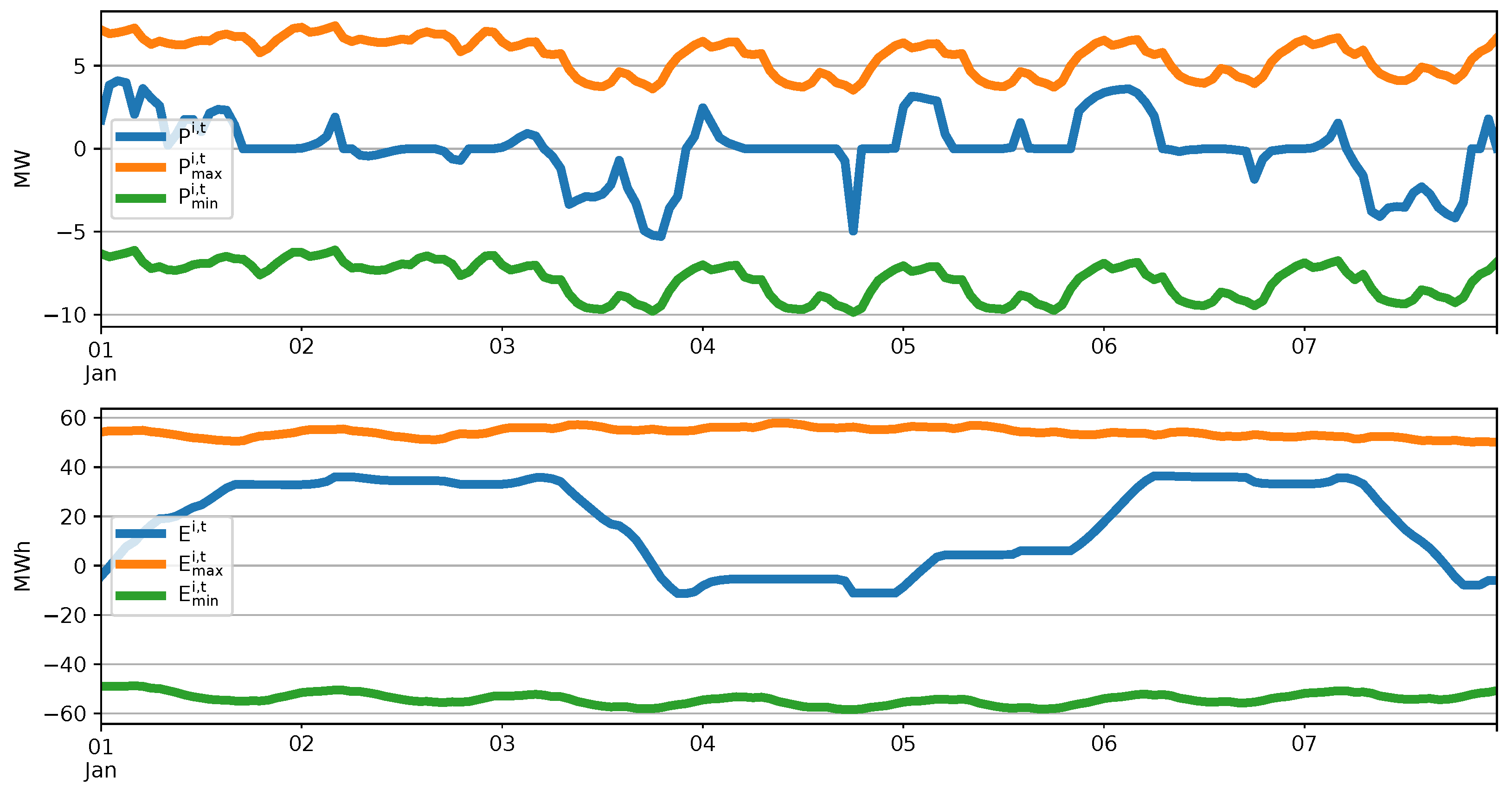
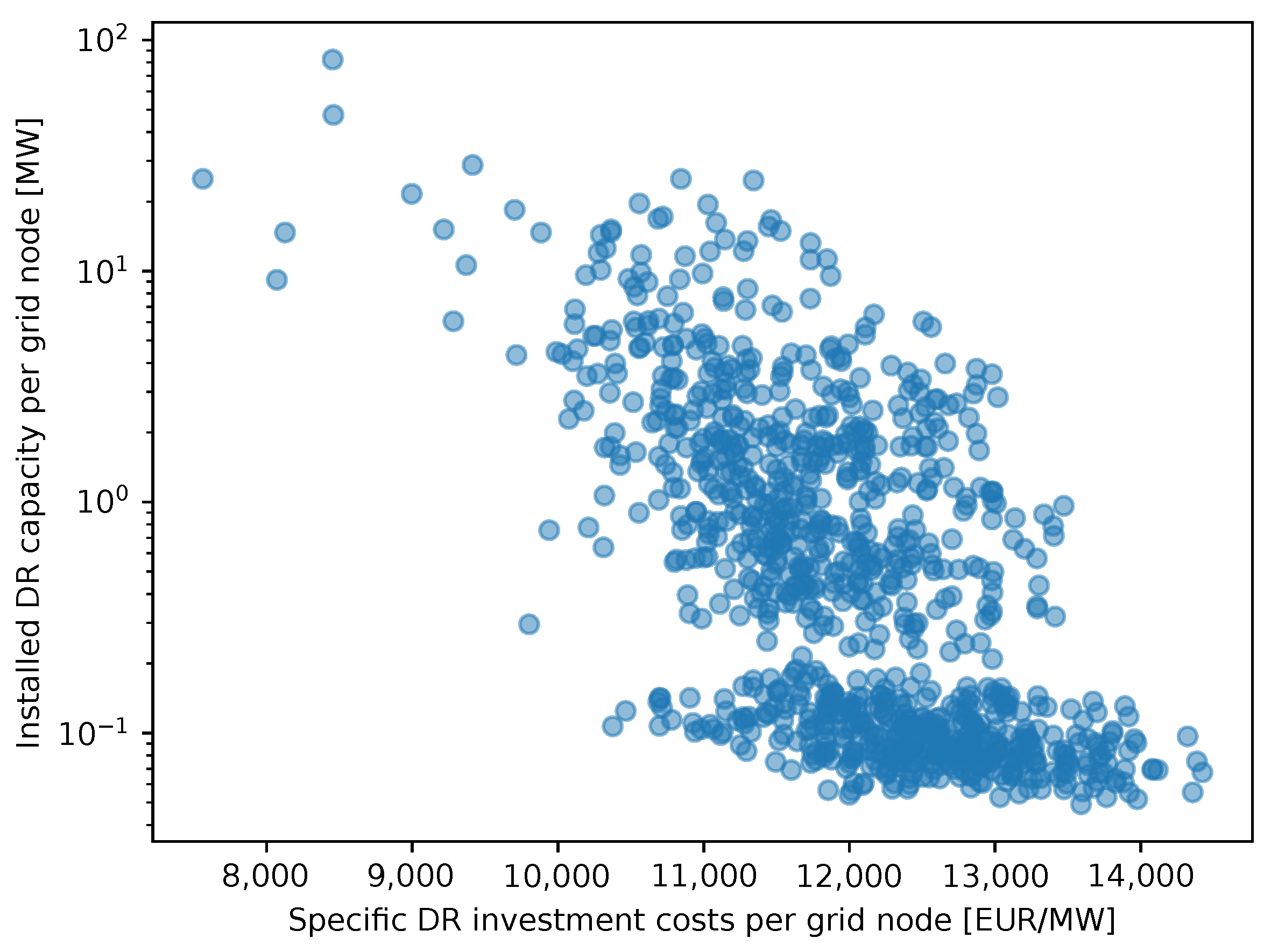
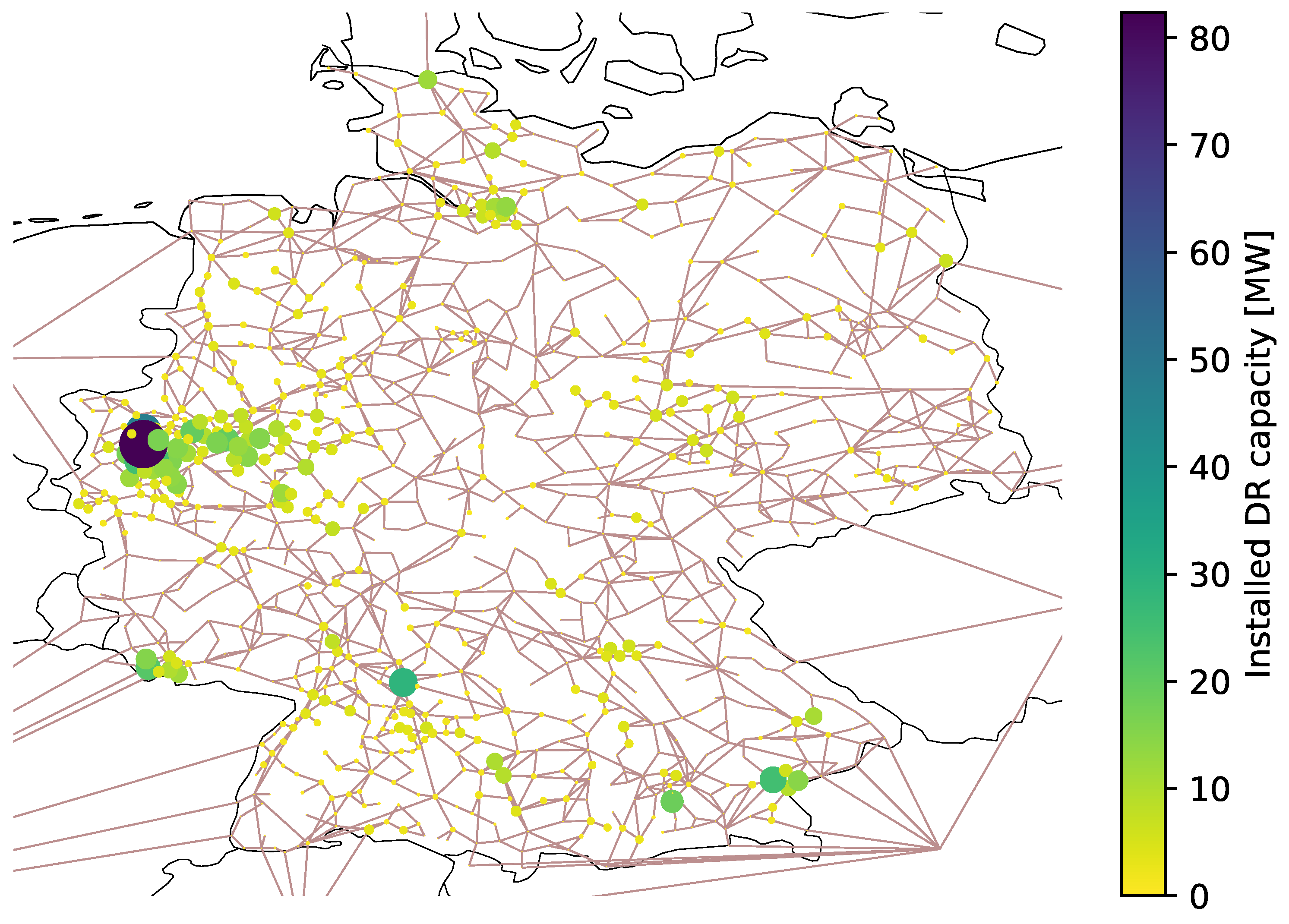
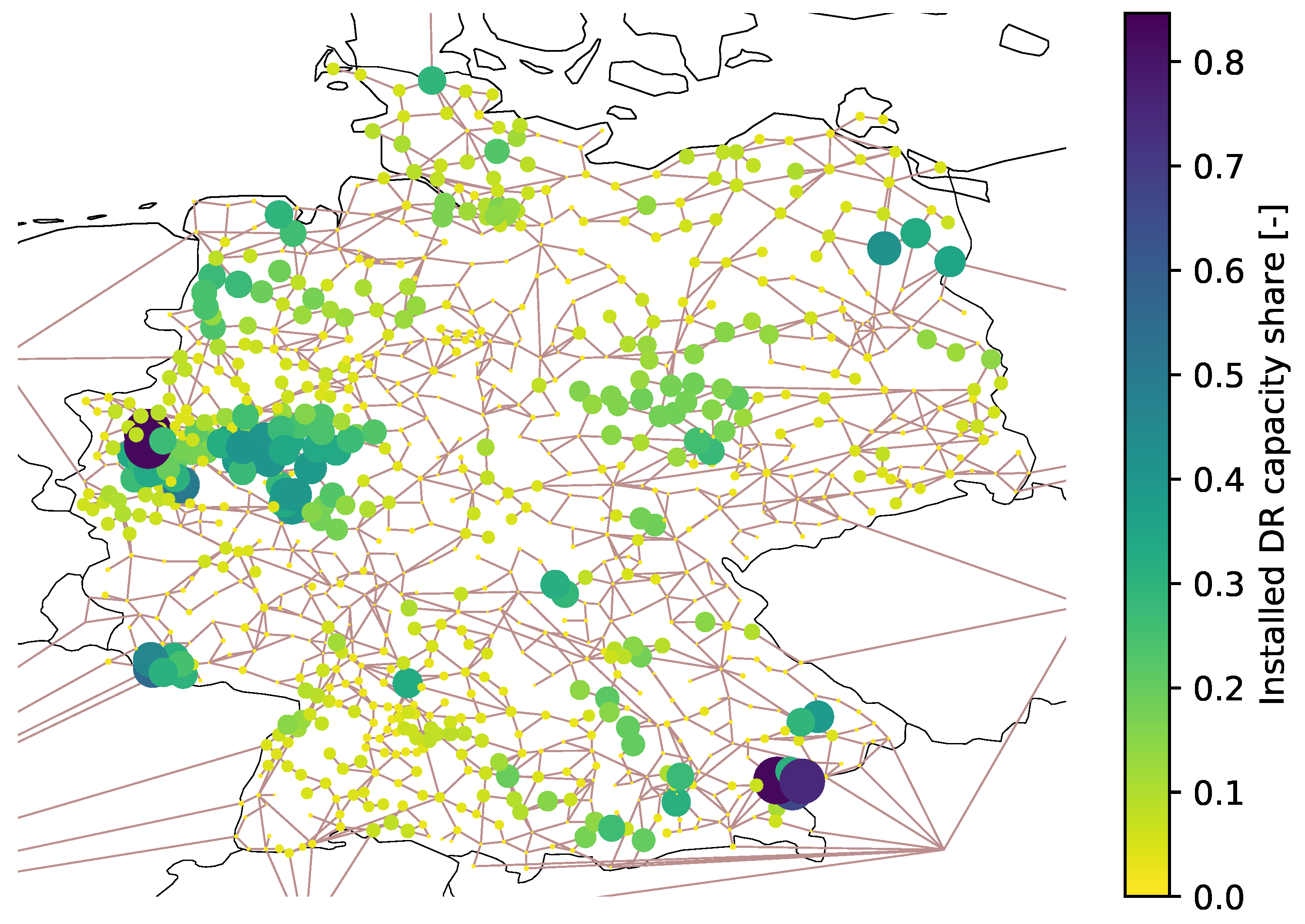
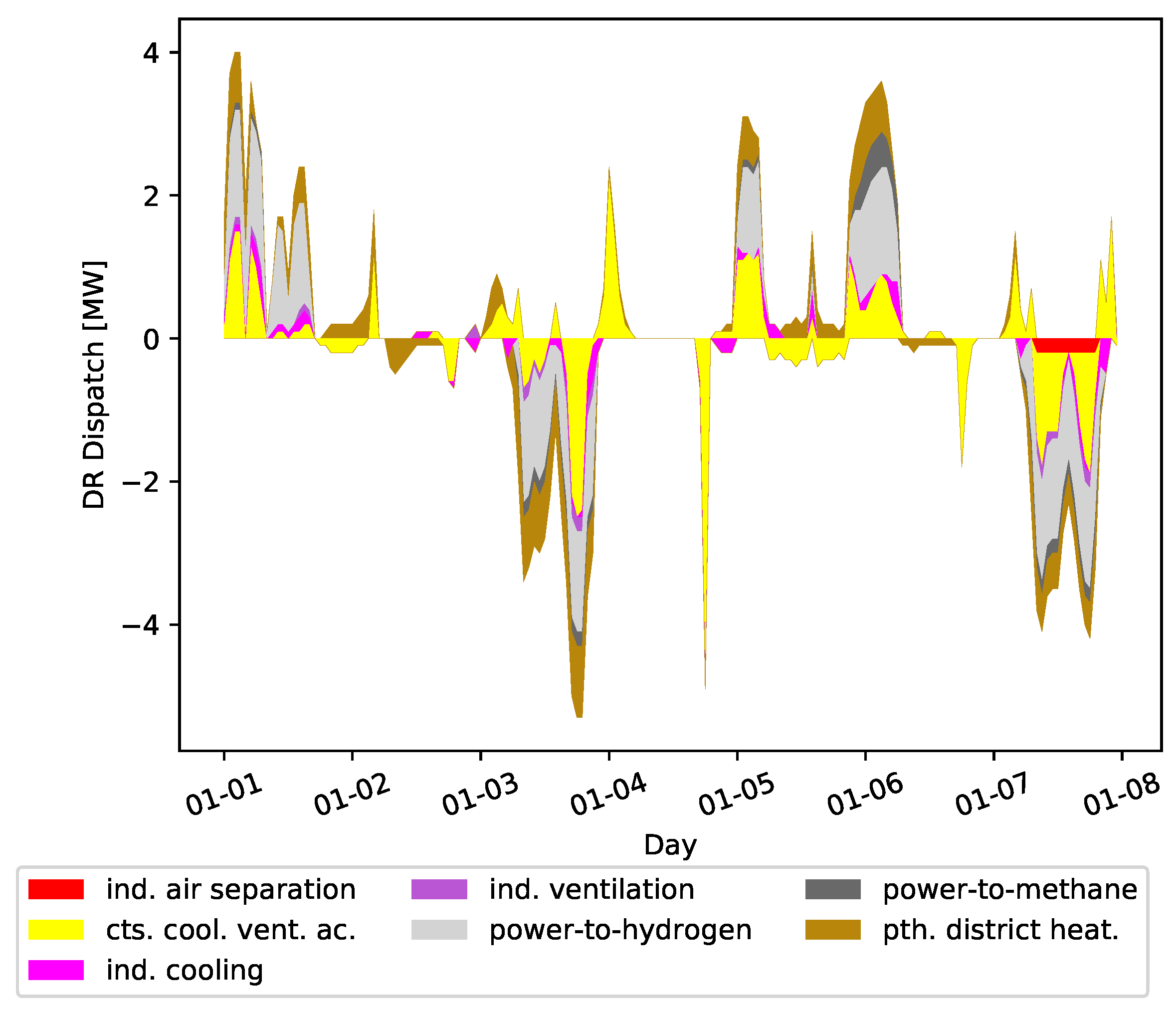
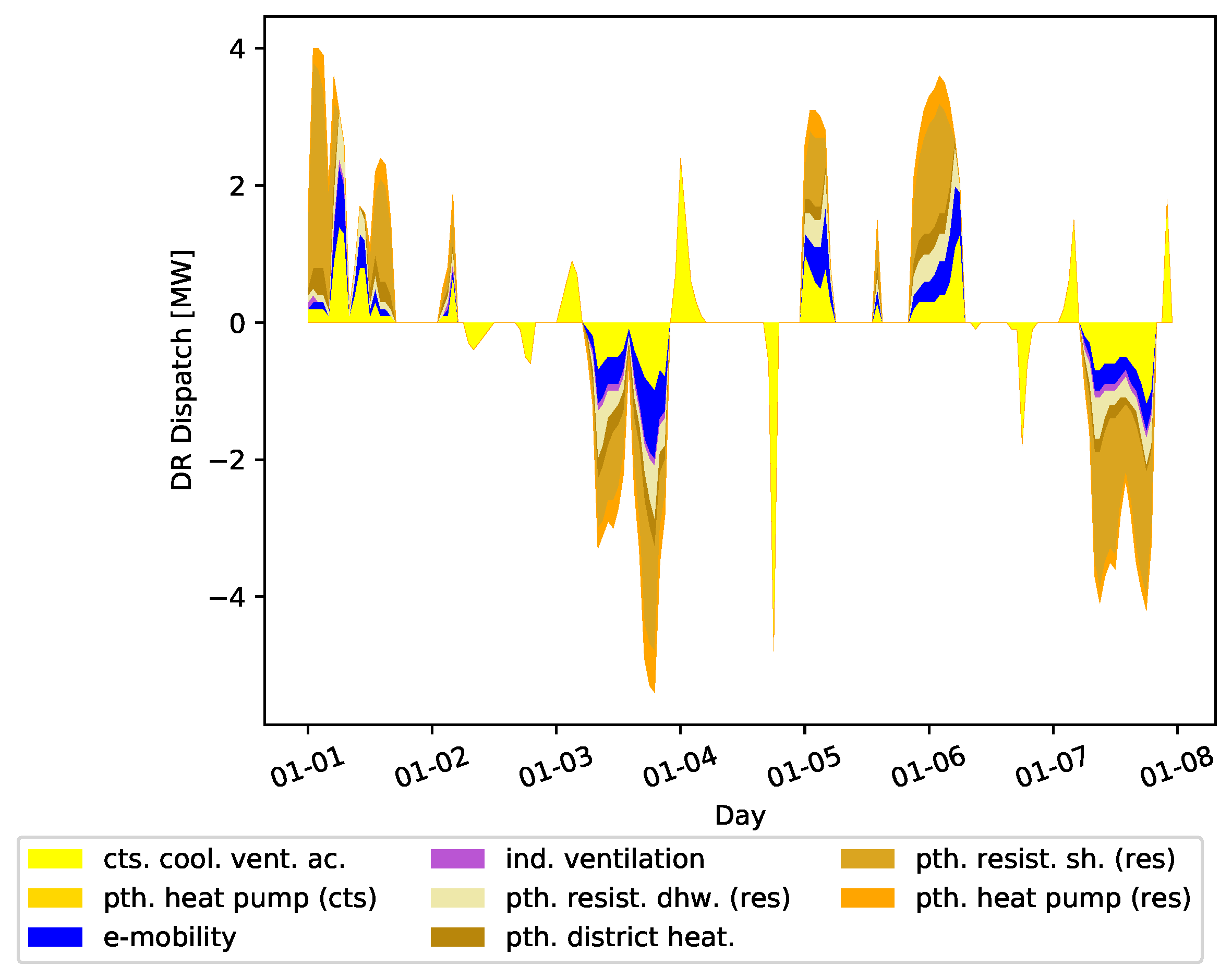
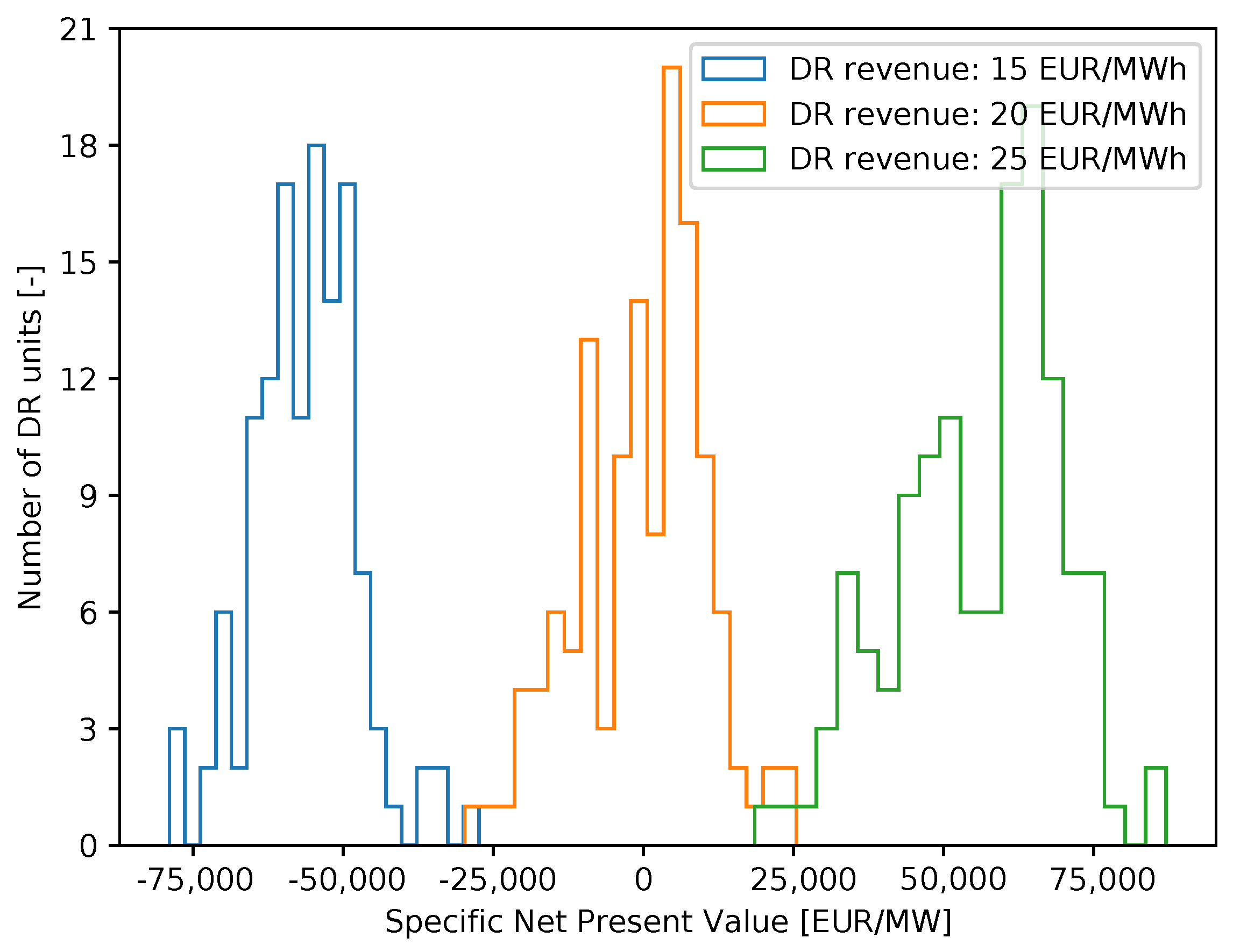

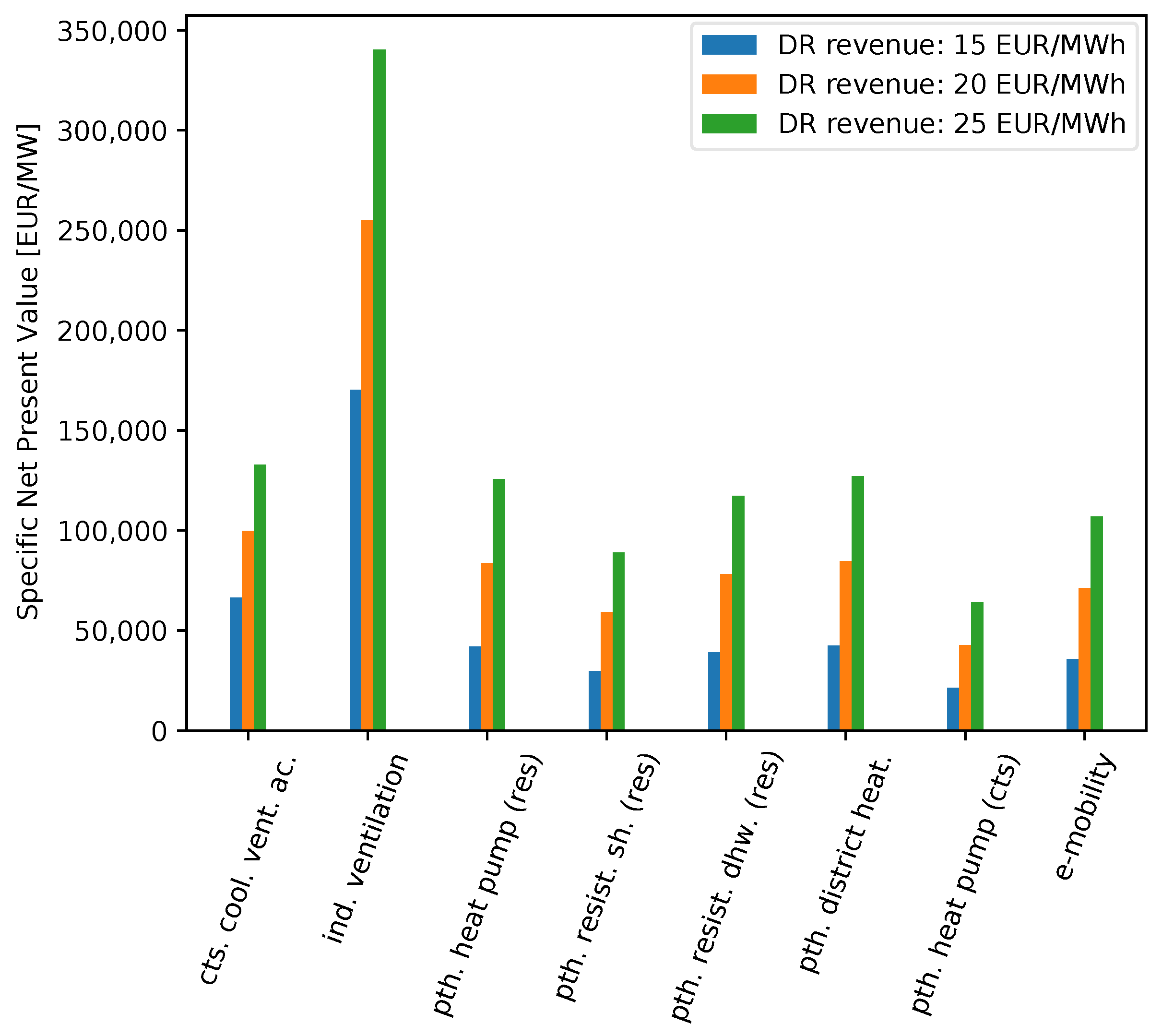
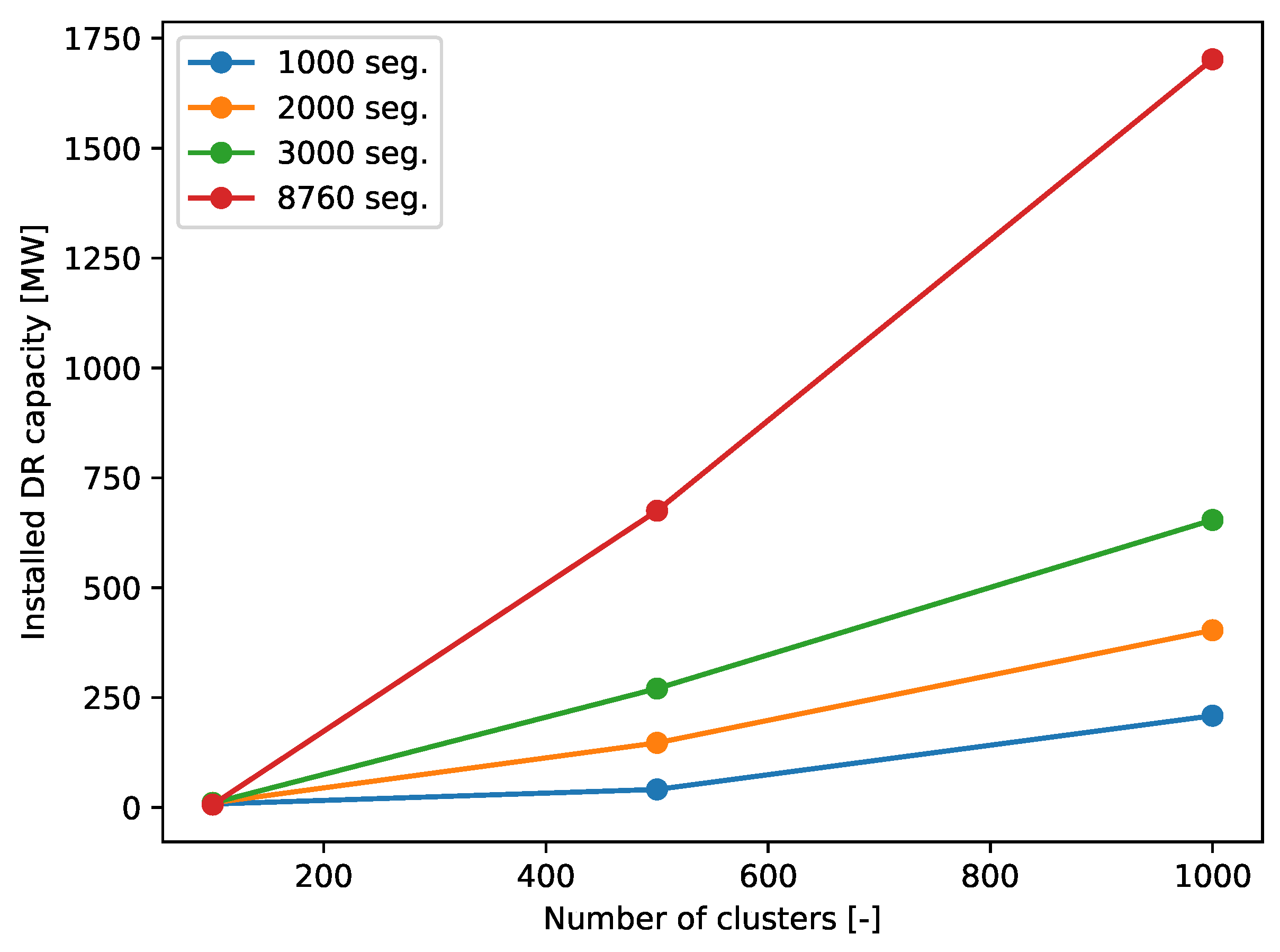
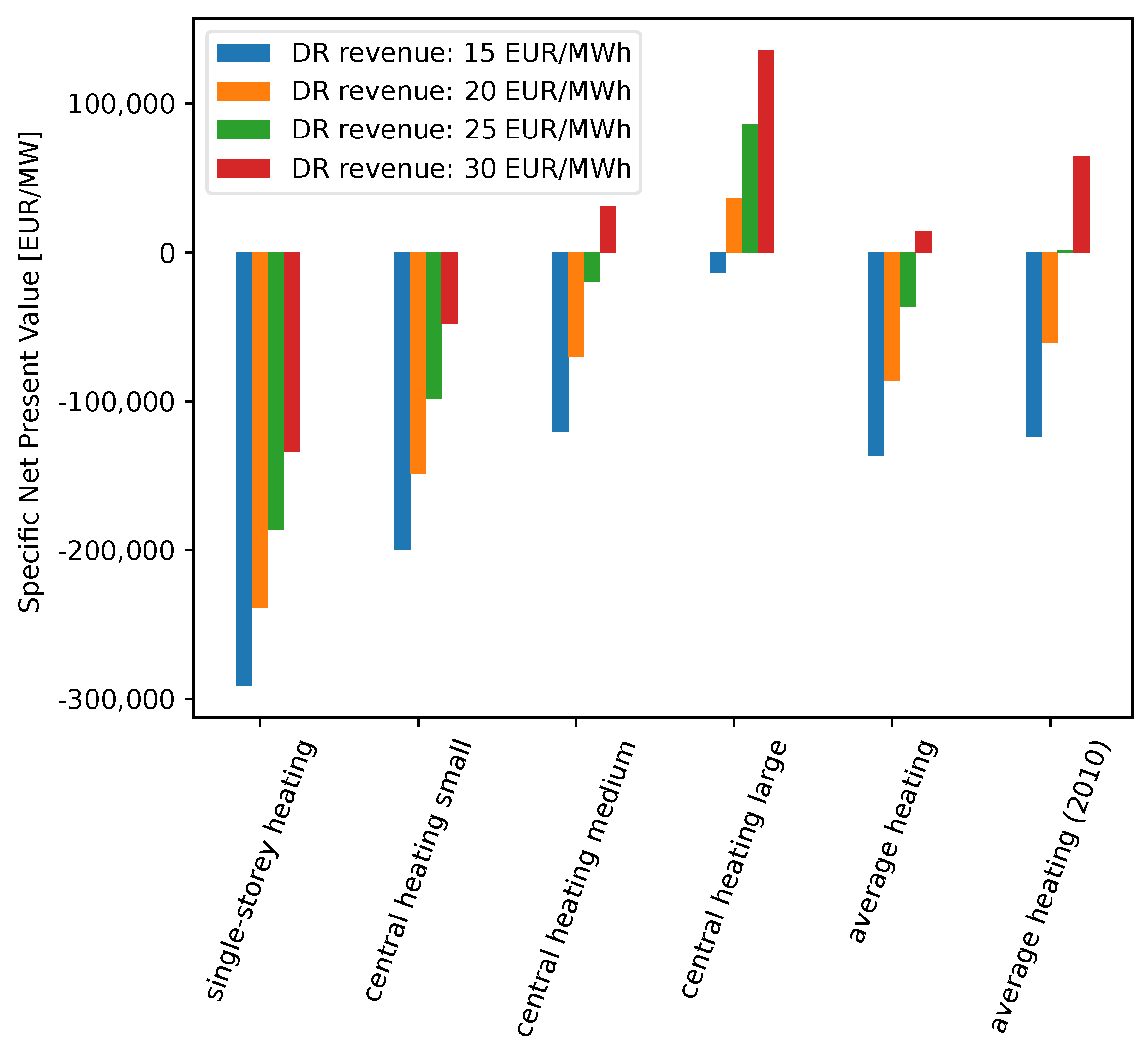
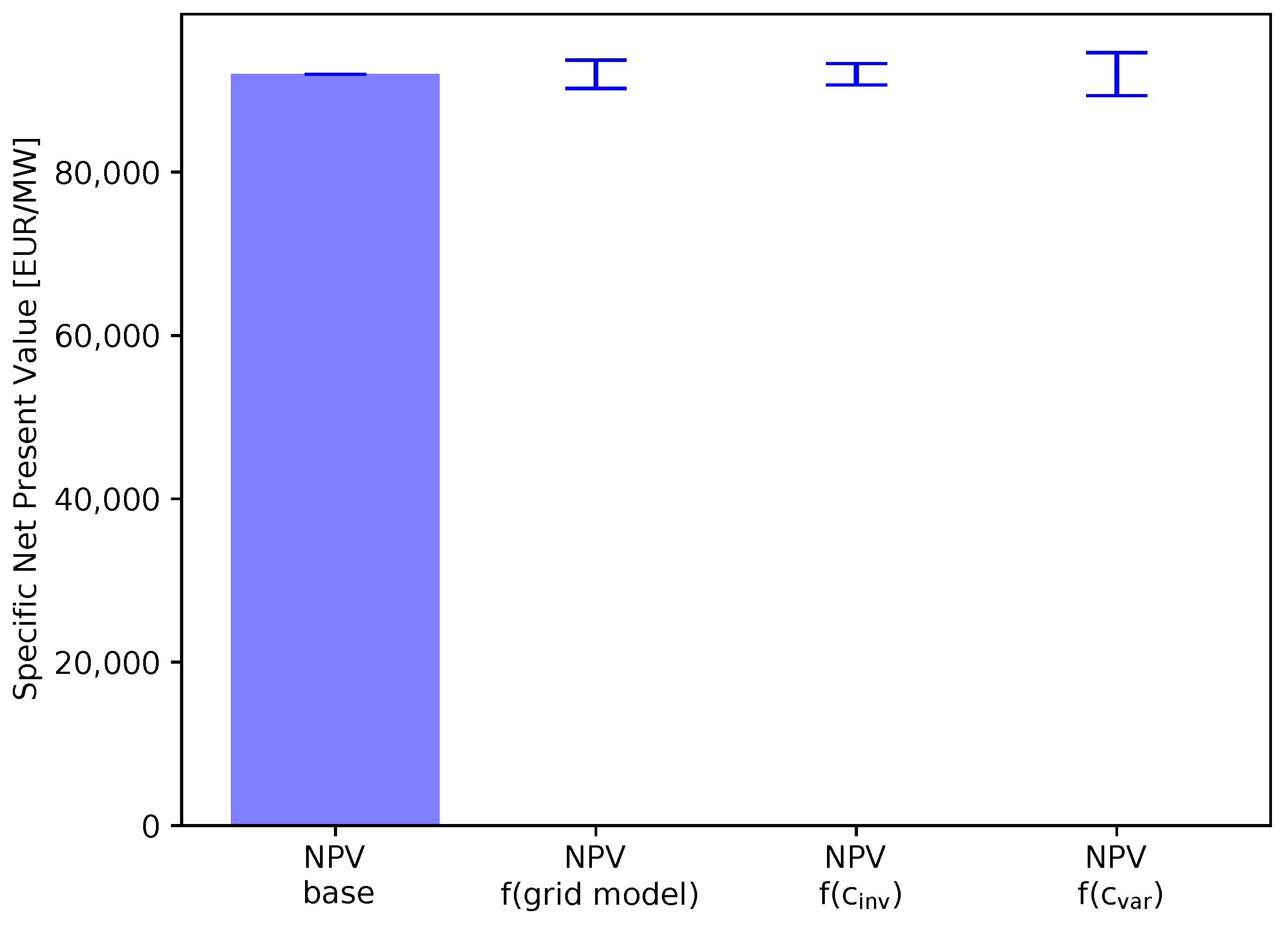
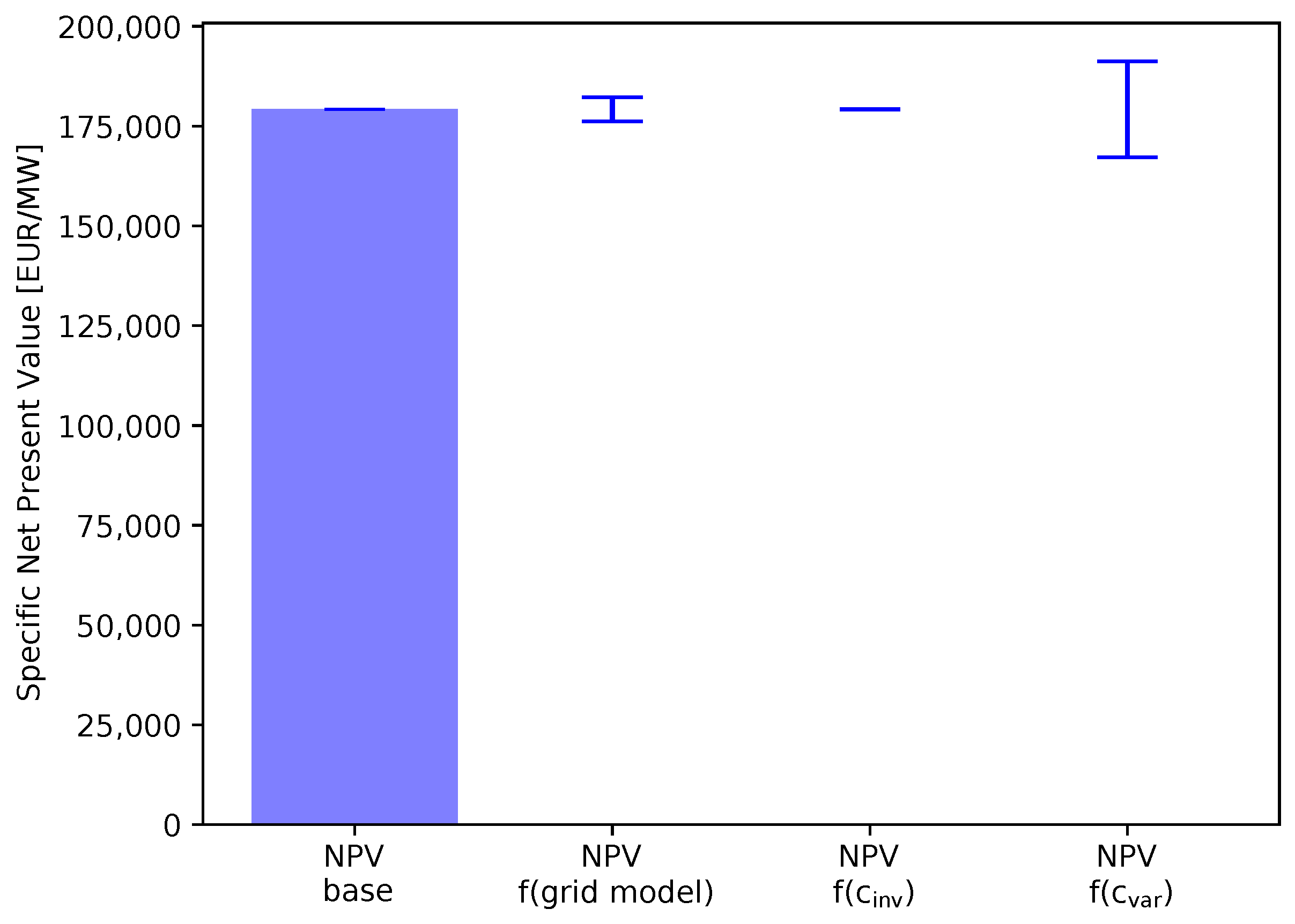
| Sector | Technology, c | (h) | (-) | (-) | (EUR/MW) | (EUR/MW/a) | (EUR/MWh) |
|---|---|---|---|---|---|---|---|
| Residential | Washing, drying | 6 | 0.0025 | 0.025 | 220,000 | 42,000 | 50 |
| Cooling, freezing | 2 | 0 | 1 | 220,000 | 42,000 | 50 | |
| CTS | Cooling, ventilation, AC | 1 | 0 | 1 | 10,000 | 300 | 5 |
| Industry | Air separation | 4 | 0.4 | 0.95 | 200 | 100 | 150 |
| Cement | 4 | 0 | 0.95 | 1500 | 19,100 | 200 | |
| Pulp | 2 | 0 | 0.95 | 2300 | 2000 | 250 | |
| Paper | 3 | 0 | 0.95 | 2300 | 2000 | 200 | |
| Recycled paper | 3 | 0 | 0.95 | 2300 | 2000 | 100 | |
| Cooling | 2 | 0.5 | 0.9 | 5000 | 150 | 20 | |
| Ventilation | 1 | 0.5 | 1 | 10,000 | 300 | 5 | |
| PtH | Process heat (ind) | 3 | 0.2 | 0.95 | 3500 | 3600 | 100 |
| Heat pumps (res) | 3 | 0 | 0.75 | 62,000 | 12,000 | 10 | |
| Resistive sh. (res) | 12 | 0 | 0.75 | 39,200 | 7000 | 10 | |
| Resistive dhw. (res) | 12 | 0 | 0.17 | 155,000 | 29,500 | 10 | |
| PtH in district heating | 12 | 0 | 0.95 | 200 | 100 | 10 | |
| Heat pumps (cts) | 3 | 0 | 0.75 | 20,000 | 600 | 10 | |
| PtG | Power-to-methane | 24 | 0 | 0.95 | 200 | 100 | 150 |
| Power-to-hydrogen | 24 | 0 | 0.95 | 200 | 100 | 150 | |
| E-mobility | E-mobility | 5 | 0 | 0.25 | 84,000 | 16,000 | 10 |
| Heat Pump Size | (kW) | (EUR/MW) |
|---|---|---|
| Single-storey heating | 2.7 | 115,000 |
| Central heating small | 3.7 | 84,000 |
| Central heating medium | 5.5 | 57,000 |
| Central heating large | 14.2 | 22,000 |
Publisher’s Note: MDPI stays neutral with regard to jurisdictional claims in published maps and institutional affiliations. |
© 2022 by the authors. Licensee MDPI, Basel, Switzerland. This article is an open access article distributed under the terms and conditions of the Creative Commons Attribution (CC BY) license (https://creativecommons.org/licenses/by/4.0/).
Share and Cite
Heitkoetter, W.; Medjroubi, W.; Vogt, T.; Agert, C. Economic Assessment of Demand Response Using Coupled National and Regional Optimisation Models. Energies 2022, 15, 8577. https://doi.org/10.3390/en15228577
Heitkoetter W, Medjroubi W, Vogt T, Agert C. Economic Assessment of Demand Response Using Coupled National and Regional Optimisation Models. Energies. 2022; 15(22):8577. https://doi.org/10.3390/en15228577
Chicago/Turabian StyleHeitkoetter, Wilko, Wided Medjroubi, Thomas Vogt, and Carsten Agert. 2022. "Economic Assessment of Demand Response Using Coupled National and Regional Optimisation Models" Energies 15, no. 22: 8577. https://doi.org/10.3390/en15228577
APA StyleHeitkoetter, W., Medjroubi, W., Vogt, T., & Agert, C. (2022). Economic Assessment of Demand Response Using Coupled National and Regional Optimisation Models. Energies, 15(22), 8577. https://doi.org/10.3390/en15228577








